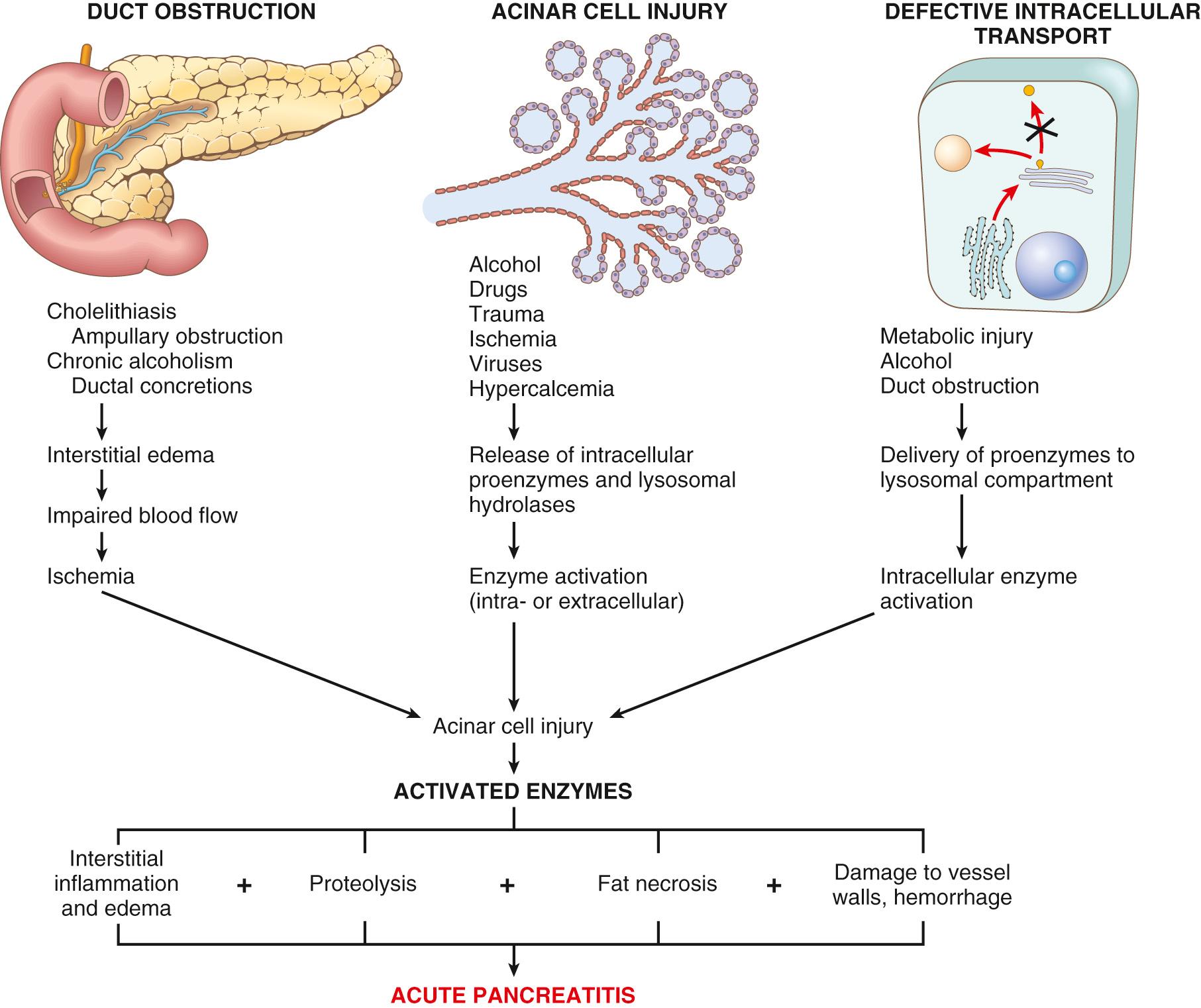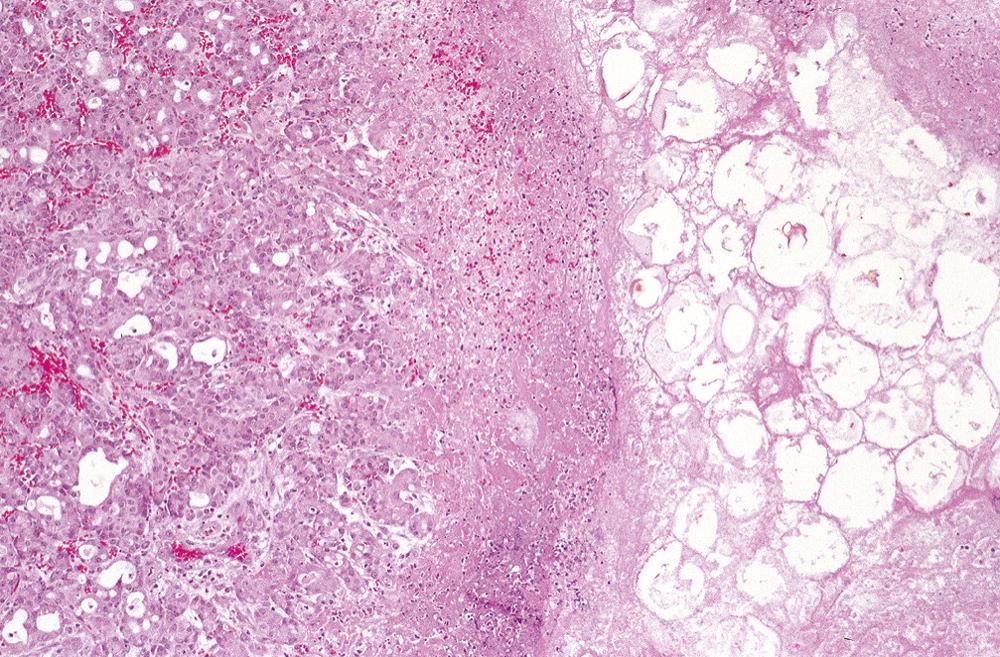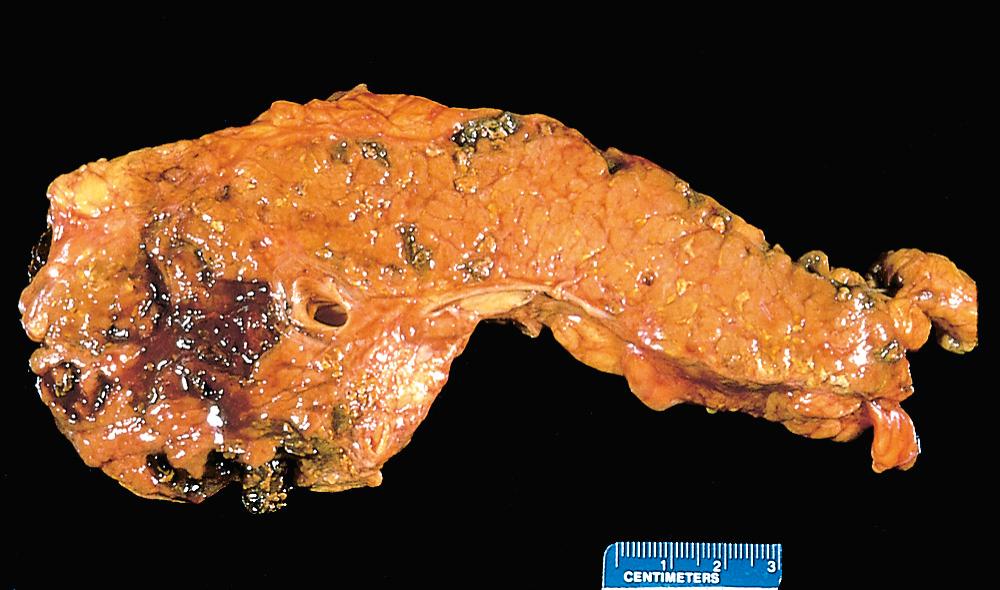Physical Address
304 North Cardinal St.
Dorchester Center, MA 02124
The adult pancreas is a transversely oriented retroperitoneal organ extending from the C-loop of the duodenum to the hilum of the spleen ( Fig. 19.1A ). Although the organ gets its name from the Greek pankreas (“all flesh”), it is in fact a complex lobulated organ with distinct exocrine and endocrine components.
The exocrine pancreas constitutes 80% to 85% of the organ and is composed of acinar cells. These pyramidally shaped epithelial cells contain membrane-bound granules rich in proenzymes (zymogens), including trypsinogen, chymotrypsinogen, procarboxypeptidase, proelastase, kallikreinogen, and prophospholipase A and B, all of which contribute to digestion. Upon secretion, these proenzymes and enzymes are carried by a series of ductules and ducts to the duodenum, where they are activated by proteolytic cleavage (described later).
The endocrine pancreas is composed of about 1 million endocrine cell clusters, the islets of Langerhans, that are scattered throughout the gland. Islet cells secrete insulin, glucagon, somatostatin, and pancreatic polypeptide. Although they constitute only 1% to 2% of the organ mass, the hormones released by the islet cells are essential regulators of systemic metabolism. Diseases of the endocrine pancreas are described in detail in Chapter 24 .
The complex process by which the dorsal and ventral pancreatic primordia fuse during pancreatic development is imperfect, giving rise to variation in pancreatic anatomy. The pancreas normally arises from the fusion of dorsal and ventral outpouchings of the foregut. The body, the tail, and the superior/anterior aspect of the head of the pancreas, as well as the accessory duct of Santorini, are derived from the dorsal primordium. Typically, the ventral primordium gives rise to the posterior/inferior part of the head of the pancreas and drains through the main pancreatic duct into the papilla of Vater.
Pancreas divisum is the most common congenital anomaly of the pancreas with an incidence of 3% to 10%. In most individuals, the main pancreatic duct (the duct of Wirsung) joins the common bile duct just proximal to the papilla of Vater, and the accessory pancreatic duct (the duct of Santorini) drains into the duodenum through a separate minor papilla (see Fig. 19.1A ). Pancreas divisum is caused by a failure of fusion of the fetal duct systems of the dorsal and ventral pancreatic primordia. As a result, in this anatomic variant the bulk of the pancreas (formed by the dorsal pancreatic primordium) drains into the duodenum through the small-caliber minor papilla ( Fig. 19.1B ), while the duct of Wirsung drains only a small portion of the head of the gland through the papilla of Vater. Although controversial, it has been suggested that inadequate drainage of the pancreatic secretions through the minor papilla, especially when combined with genetic defects that also increase susceptibility to pancreatitis (described later), predisposes individuals with pancreatic divisum to chronic pancreatitis.
Annular pancreas is a band-like ring of normal pancreatic tissue that completely encircles the second portion of the duodenum. Annular pancreas can produce duodenal obstruction.
Pancreatic tissue that is aberrantly situated, or ectopic, is found in about 2% of careful routine postmortem examinations. The favored sites for ectopia are the stomach and duodenum, followed by the jejunum, Meckel diverticula, and ileum. Although usually incidental findings, these embryologic rests, composed of normal-appearing pancreatic acini, glands, and sometimes islets of Langerhans, may cause pain from localized inflammation or may incite mucosal bleeding.
Very rarely the pancreas fails to develop (agenesis). Some cases of agenesis are caused by homozygous germline mutations involving PDX1, a gene encoding a homeobox transcription factor that is critical for pancreatic development.
Pancreatitis is divided into two forms, acute and chronic, each with its own characteristic pathologic and clinical features; both are initiated by injuries that lead to autodigestion of the pancreas by its own enzymes. Under normal circumstances, several factors protect the pancreas from autodigestion.
Most digestive enzymes are synthesized as inactive proenzymes (zymogens) and packaged within secretory granules.
Proenzymes are typically activated by trypsin, which itself is activated by duodenal enteropeptidase (enterokinase) in the small bowel; as a result, intrapancreatic activation of proenzymes is normally minimal.
Acinar and ductal cells secrete trypsin inhibitors, including serine protease inhibitor Kazal type l (SPINK1), which further limit intrapancreatic trypsin activity.
Pancreatitis occurs when these protective mechanisms are disrupted or overwhelmed. Acute attacks may range from mild and self-limited to life-threatening events. Recurrent or persistent pancreatitis may lead to permanent loss of pancreatic function.
Acute pancreatitis is characterized by reversible pancreatic parenchymal injury and inflammation and has many causes, including toxic exposures (e.g., alcohol), pancreatic duct obstruction (e.g., biliary calculi), inherited genetic defects, vascular injury, and infections. Acute pancreatitis is relatively common with an annual incidence in Western countries of 10 to 20 cases per 100,000 people. Biliary tract disease and alcoholism account for approximately 80% of these cases ( Table 19.1 ). The proportion of cases caused by excessive alcohol intake varies from 65% in the United States to 20% in Sweden to 5% or less in southern France and the United Kingdom. The male-to-female ratio is 6:1 in those with alcoholism and 1:3 in patients with biliary tract disease. Gallstones are present in 35% to 60% of acute pancreatitis cases and cause “gallstone pancreatitis” in about 5% of patients with gallstones.
| Metabolic |
| Alcoholism a Hyperlipoproteinemia Hypercalcemia Drugs (e.g., azathioprine, statins, GLP-1 agonists, DPP-4 inhibitors) |
| Genetic |
| Mutations in genes encoding trypsin (PRSS1), trypsin regulators (SPINK1), or proteins that regulate calcium metabolism (CASR) Cystic fibrosis (CFTR) |
| Mechanical |
| Gallstones a Trauma Iatrogenic injury Operative injury Endoscopic procedures with dye injection (e.g., ERCP) |
| Vascular |
| Shock Atheroembolism Vasculitis (e.g., polyarteritis nodosa) |
| Infectious |
| Mumps |
| Coxsackievirus |
Acute pancreatitis results from inappropriate release and activation of pancreatic enzymes that, in turn, destroy pancreatic tissue and elicit an acute inflammatory reaction. Inappropriate trypsin activation within the pancreas can activate other proenzymes such as prophospholipase and proelastase, which degrade fat cells and damage the elastic fibers of blood vessels, respectively. Once tissue damage commences, trypsin can also directly or indirectly activate factors found in the blood, including components of the coagulation, complement, kallikrein, and fibrinolytic pathways ( Chapters 3 and 4 ). The resulting inflammation and small-vessel thrombosis causes further damage to acinar cells, amplifying intrapancreatic enzyme activation.
The triggers that cause intrapancreatic enzyme activation in sporadic acute pancreatitis remain a topic of investigation, but there is evidence for at least three major initiating events ( Fig. 19.2 ):
Pancreatic duct obstruction is most commonly caused by gallstones and biliary sludge but can also stem from periampullary neoplasms (e.g., pancreatic cancer), choledochoceles (congenital cystic dilation of the common bile duct), parasites (particularly Ascaris lumbricoides and Clonorchis sinensis ), and possibly pancreas divisum. Obstruction raises intrapancreatic ductal pressure and leads to accumulation of enzyme-rich fluid within the interstitium. Unlike other pancreatic enzymes, lipase is secreted in an active form and has the potential to cause local fat necrosis. The death of adipocytes is hypothesized to produce “danger” signals locally that are sensed by pancreatic stellate cells and leukocytes, which release proinflammatory mediators that promote microvascular leak and development of interstitial edema. Edema may further compromise local blood flow, causing vascular insufficiency and ischemic injury to acinar cells.
Primary acinar cell injury leads to release of digestive enzymes, inflammation, and tissue autodigestion. Acinar cells can be damaged by a variety of endogenous, exogenous, and iatrogenic insults. Many of these result in oxidative stress and generation of intracellular free radicals that lead to membrane lipid oxidation and transcription factor activation. The latter include AP1 and NF-κB, which induce expression of chemokines that attract mononuclear cells. Increased calcium flux is another important trigger for inappropriate enzyme activation. Calcium has a key role in trypsin regulation. When calcium levels are low, trypsin tends to cleave and inactivate itself, but this autoinhibition is abrogated and trypsin autoactivation is favored when calcium levels are increased. Any factor causing increased calcium within acinar cells may therefore trigger excessive trypsin activation. Examples include inherited abnormalities that affect calcium levels ( Table 19.2 ).
| Gene (Chromosome Location) | Protein Product | Function |
|---|---|---|
| CFTR (7q31) | Cystic fibrosis transmembrane conductance regulator | Epithelial anion channel. Loss-of-function mutations alter fluid pressure and limit bicarbonate secretion, leading to inspissation of secreted fluids and duct obstruction |
| PRSS1 (7q34) | Serine protease 1 (trypsinogen 1) | Cationic trypsin. Gain-of-function mutations prevent self-inactivation of trypsin |
| SPINK1 (5q32) | Serine peptidase inhibitor, Kazal type 1 | Inhibitor of trypsin. Mutations cause loss-of-function, increasing trypsin activity |
| CASR (3q13) | Calcium-sensing receptor | Membrane-bound receptor that senses extracellular calcium levels and controls luminal calcium levels. Mutations may alter calcium concentrations and activate trypsin |
| CTRC (1p36) | Chymotrypsin C (caldecrin) | Degrades trypsin, protects the pancreas from trypsin-related injury |
| CPA1 (7q32) | Carboxypeptidase A1 | Exopeptidase involved in regulating zymogen activation |
Defective intracellular transport of proenzymes within acinar cells. In normal acinar cells, digestive enzymes and lysosomal hydrolases are transported via separate pathways. In animal models of acinar injury, pancreatic proenzymes, of which the cathepsin family of hydrolases is most important, are aberrantly delivered to lysosomes. The hydrolases then activate pancreatic proenzymes that disrupt lysosomal membranes, ultimately leading to release of activated enzymes. It is not clear if this mechanism is relevant to human acute pancreatitis.

Two factors have been proposed to contribute to alcohol-induced pancreatitis: duct obstruction and acinar cell damage. Alcohol consumption transiently increases contraction of the sphincter of Oddi (the muscle at the papilla of Vater), and chronic alcohol ingestion results in the secretion of protein-rich pancreatic fluid that is prone to form inspissated protein plugs that obstruct small pancreatic ducts. Within acinar cells, alcohol-induced oxidative stress may generate free radicals, leading to membrane lipid oxidation and activation of the proinflammatory transcription factors AP1 and NF-κB. Oxidative stress also may promote fusion of lysosomes and zymogen granules and increase intracellular calcium levels, possibly through mitochondrial damage, thereby promoting the intracellular activation of trypsin and other digestive enzymes. Nevertheless, it should be noted that most alcoholics never develop pancreatitis and those who do usually do so after many years of alcohol abuse. Thus, key aspects of the pathophysiology of alcohol-induced pancreatitis remain obscure.
Other proven or suspected triggers of acute pancreatitis in sporadic cases include (see Table 19.1 ):
Metabolic disorders such as hypertriglyceridemia and hypercalcemic states, as in hyperparathyroidism.
Genetic lesions, as described below.
Medications. Hundreds of drugs have been anecdotally linked to acute pancreatitis, but only about 50 have a definite association. The latter include azathioprine, angiotensin-converting enzyme (ACE) inhibitors, statins, and antidiabetic drugs such as glucagon-like peptide-1 (GLP-1) agonists and dipeptidyl peptidase-4 (DPP-4) inhibitors.
Traumatic acinar cell injury, by either blunt abdominal trauma or iatrogenic injury during surgery or endoscopic retrograde cholangiopancreatography.
Ischemic acinar cell injury due to shock, vascular thrombosis, embolism, or vasculitis.
Infections, including mumps, can lead to acute pancreatitis through direct acinar cell injury,
Hereditary factors are increasingly recognized as causes of pancreatitis. Affected individuals have recurrent attacks of severe acute pancreatitis, which often begin in childhood, and can ultimately lead to chronic pancreatitis. The feature shared by most forms of hereditary pancreatitis is a defect that increases or sustains the activity of trypsin (see Table 19.2 ). Three genes implicated in hereditary pancreatitis deserve special note: PRSS1, SPINK1, and CFTR . Most hereditary cases are due to gain-of-function mutations in the trypsinogen gene (known as PRSS1 ). Some of these PRSS1 gene mutations make trypsin resistant to self-inactivation, abrogating an important negative feedback mechanism; other mutations make trypsinogen more prone to proteolytic activation. Hereditary pancreatitis associated with trypsinogen mutation has an autosomal dominant mode of inheritance, as is typically true of disorders associated with gain-of-function mutations.
Hereditary pancreatitis can also be caused by loss-of-function mutations in SPINK1, a gene encoding a trypsin inhibitor. Because one functional copy of SPINK1 produces sufficient inhibitor to maintain adequate trypsin control, this form of hereditary pancreatitis has an autosomal recessive mode of inheritance.
As discussed in detail in Chapter 10 , cystic fibrosis is caused by mutations in the cystic fibrosis transmembrane conductance regulator (CFTR) gene that encodes an apical chloride channel. Loss of CFTR leads to abnormal secretions that promote protein plugging, duct obstruction, and the development of pancreatitis. Disease can occur in those with homozygous and even heterozygous CFTR gene mutations, particularly in patients who also have SPINK1 mutations.
Of note, patients with PRSS1 -associated hereditary pancreatitis have a 40% lifetime risk of developing pancreatic cancer, yet another example of the nefarious association between neoplasia and chronic tissue injury and inflammation.
The morphology of acute pancreatitis ranges from limited inflammation and edema to extensive necrosis and hemorrhage. The basic alterations are (1) microvascular leak and edema, (2) fat necrosis, (3) acute inflammation, (4) damage, including autodigestion, of pancreatic parenchyma, and (5) blood vessel destruction with interstitial hemorrhage. The extent of each of these depends on the duration and severity of disease.
In more limited forms of acute interstitial pancreatitis, histologic alterations are limited to mild inflammation, interstitial edema, and focal fat necrosis within the pancreas and the peripancreatic fat ( Fig. 19.3 ). Fat necrosis, triggered by lipase activity, leads to saponification, a process in which fatty acids combine with calcium to form insoluble calcium soaps that impart a granular blue microscopic appearance to surviving fat cells ( Chapter 2 ).
In acute necrotizing pancreatitis, acini, ducts, and even islets undergo necrosis. In the most severe form, hemorrhagic pancreatitis, extensive parenchymal necrosis is accompanied by intraparenchymal hemorrhage due to vascular injury. This imparts a red-black color with interspersed foci of yellow-white, chalky fat necrosis ( Fig. 19.4 ). Fat necrosis may also occur in the omentum and the mesentery of the bowel adjacent to the pancreas and beyond the abdominal cavity, such as in the subcutaneous fat, as a result of systemic lipase release. The peritoneal cavity typically contains a serous, slightly turbid, brown-tinged fluid with fat globules that reflect digestion of adipose tissue.


Abdominal pain is the cardinal manifestation of acute pancreatitis. Characteristically the pain is constant, intense, and referred to the upper or mid back and, occasionally, the left shoulder. The severity ranges from mild discomfort to incapacitating pain. Anorexia, nausea, and vomiting are common. Elevated plasma levels of amylase and lipase support the diagnosis of acute pancreatitis, as does the exclusion of other causes of abdominal pain.
Severe acute pancreatitis is a medical emergency. Patients usually present with an acute abdomen and systemic findings caused by the release of toxic enzymes, cytokines, and other mediators into the circulation. These activate a systemic inflammatory response, resulting in leukocytosis, disseminated intravascular coagulation, edema, and acute respiratory distress syndrome. Shock, due to the systemic inflammatory response syndrome ( Chapter 4 ), and acute renal tubular necrosis may occur.
Laboratory findings include elevation of serum amylase and lipase levels during the first 4 to 12 hours following the onset of pain. Serum lipase is the most specific and sensitive marker of acute pancreatitis, as serum amylase has a short half-life and may return to normal in 3 to 5 days, whereas lipase levels remain elevated for 8 to 14 days. Glycosuria occurs in 10% of cases, and hypocalcemia may result from saponification of necrotic fat. Direct visualization of the enlarged inflamed pancreas by computed tomography (CT) scanning is useful in the diagnosis of pancreatitis.
Treatment centers on “resting” the pancreas by total elimination of oral intake and supportive therapy with intravenous fluids and analgesia. Most individuals with acute pancreatitis recover fully but about 5% with severe acute pancreatitis die in the first week of illness. Acute respiratory distress syndrome and acute renal failure are ominous complications. Possible sequelae include sterile pancreatic abscesses and pancreatic pseudocysts. In 40% to 60% of patients with acute necrotizing pancreatitis the acellular debris becomes infected, usually by gram-negative organisms from the gut, further complicating the clinical course. Systemic organ failure and pancreatic necrosis are both adverse prognostic indicators.
Acute pancreatitis is a form of reversible pancreatic parenchymal injury associated with inflammation.
Acute pancreatitis may be caused by:
Excessive alcohol intake
Pancreatic duct obstruction (e.g., gallstones)
Genetic factors (e.g., PRSS1, SPINK1, CFTR )
Traumatic injuries
Medications
Infections (e.g., mumps or coxsackievirus)
Metabolic disorders leading to hypercalcemia
Ischemia
The key feature common to all these causes is that they promote inappropriate activation of digestive enzymes within the pancreas.
Clinical features include acute abdominal pain, systemic inflammatory response syndrome, and elevated serum lipase and amylase levels.
Chronic pancreatitis is defined as prolonged inflammation of the pancreas associated with irreversible destruction of exocrine parenchyma, fibrosis, and, in the late stages, loss of endocrine parenchyma. The prevalence of chronic pancreatitis is between 0.04% and 5%; most affected patients are middle-aged males. The most common cause of chronic pancreatitis is long-term alcohol use. In addition to alcohol, chronic pancreatitis has been associated with the following conditions:
Long-standing obstruction of the pancreatic duct by calculi or neoplasms
Autoimmune injury
Hereditary factors, as discussed above; up to 25% of chronic pancreatitis has a genetic basis
Become a Clinical Tree membership for Full access and enjoy Unlimited articles
If you are a member. Log in here